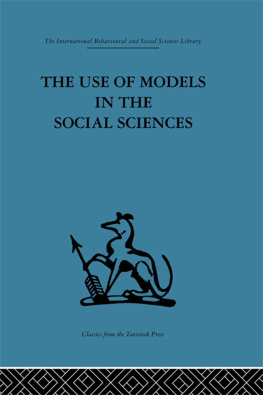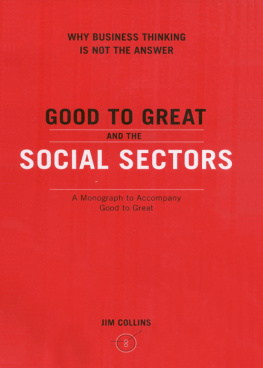The International Behavioural and Social Sciences Library
THE USE OF MODELS IN THE SOCIAL SCIENCES
TAVISTOCK
The International Behavioural and Social Sciences Library
SOCIOLOGY & SOCIAL POLICY In 10 Volumes
| I | Social Theory and Economic Change |
| Edited by Tom Burns and S DSaul |
| II | Social Science and Government |
| Edited by AB Cherns, et al. |
| III | The Use of Models in the Social Sciences |
| Edited by Lyndhbrst Collins |
| IV | Sociology and Development |
| Edited by Emanuel de Kadt and Gavin Williams |
| V | Public Planning |
| J K Friend, et al |
| VI | Immigration and Social Policy in Britain |
| Catherine Jones |
| VII | The Social Analysis of Class Structure |
| Edited by Frank Parkin |
| VIII | The Rules of the Game |
| Edited by Teodor S hanin |
| XI | Value Systems and Social Process |
| Geoffrey Wickers |
| X | The Action-Image of Society |
| Alfred Willener |
THE USE OF MODELS IN THE SOCIAL SCIENCES
EDITED BY LYNDHURST COLLINS
First published in 1976 by
Tavistock Publications Limited
Reprinted in 2001 by
Routledge
2 Park Square,Milton Park, Abingdon, Oxon, 0X14 4RN
Transferred to Digital Printing 2007
Routledge is an imprint of the Taylor & Francis Group
1976 Seminars Committee of the Faculty of Social Sciences of the University of Edinburgh
All rights reserved. No part of this book may be reprinted or reproduced or utilized in any form or by any electronic, mechanical, or other means, now known or hereafter invented, including photocopying and recording, or in any information storage or retrieval system, without permission in writing from the publishers.
The publishers have made every effort to contact authors/copyright holders of the works reprinted in theInternational Behavioural and Social Sciences Library. This has not been possible in every case, however, and we would welcome correspondence from those individuals/companies we have been unable to trace.
These reprints are taken from original copies of each book. In many cases the condition of these originals is not perfect. The publisher has gone to great lengths to ensure the quality of these reprints, but wishes to point out that certain characteristics of the original copies will, of necessity, be apparent in reprints thereof.
British Library Cataloguing in Publication Data
A CIP catalogue record for this book is available from the British Library
The Use of Models in the Social Sciences
ISBN 0415264979
Sociology &Social Policy: 10 Volumes
ISBN 041526517 7
The International Behavioural and Social Sciences Library
112 Volumes
ISBN 0415 256704
ISBN 9781136444968 (epub)
Printed and bound by CPI Antony Rowe, Eastbourne
Edited by
LYNDHURST COLLINS
TAVISTOCK PUBLICATIONS
First published in 1976
by Tavistock Publications Limited
2 Park Square, Milton Park,
Abingdon, Oxon, 0X14 4RN
1976 Seminars Committee of the
Faculty of Social Sciences of the University of Edinburgh
I SBN 0 422 74620 7 (hardback)
Contributors
PETER ABELL Reader in Industrial Sociology, Imperial College, University of London
K. C. BOWEN Head of Research, Defence Operational Analysis Establishment, Ministry of Defence
LYNDHURST COLLINS Lecturer in Industrial Geography, University of Edinburgh
ROM HARR Fellow of Linacre College, Oxford and University Lecturer in the Philosophy of Science
MARY HESSE Reader in Philosophy of Science, University of Cambridge
DAVID HOLLOWAY Lecturer in Politics, University of Edinburgh
C.A.ISNARD Professor of Mathematics, IMPA, Rio de Janeiro
JOHN LYONS Professor of General Linguistics, University of Edinburgh
DONALD MICHIE Professor of Machine Intelligence, University of Edinburgh
DAVID G.SMITH Defence Operational Analysis Establishment, Ministry of Defence
E.C. ZEEMAN Professor and Director of Mathematics Research Centre, University of Warwick
Contents
Editors Preface page
Editors Preface
The most notable feature of the social sciences during the last two decades has been the dramatic increase in the use of models. The injection of complex philosophies, sophisticated mathematical formulations, and elaborate computer technology into the study of human behaviour has meant the transcending of traditionally narrow disciplinary boundaries of individual social sciences. Against this background of change, the Seminars Committee of the Faculty of Social Sciences in the University of Edinburgh was encouraged for its tenth annual meeting to sponsor a seminar which called upon the expertise of scholars in the related disciplines of Mathematics, Philosophy, Computer Studies, Engineering, and Linguistics as well as those within the social sciences to discuss The Use of Models in the Social Sciences. This volume contains the papers presented to the July 1972 Seminar.
The first two papers by Mary Hesse and Rom Harr concern the philosophy of model use. Hesses paper focuses on the role of models in the natural sciences but holds and elaborates the view that an understanding of the place of models in natural science may illuminate theory construction in social science. Harrs paper extends the discussion of model use in the natural sciences to suggest an approach to model use in social psychology. The most unusual paper in the volume is perhaps that by Isnard and Zeeman, who introduce a new paradigm to the social sciences. Their elaboration of the catastrophe model, which in the seminar was illustrated by a mechanical analogue, is set within the framework of public opinion and government policy. The use of models with reference to government and political issues is a theme developed in two other papers. The first, by Bowen and Smith of the Ministry of Defence, employs notions drawn from systems theory to outline the role of models concerned with conflict problems, particularly problems of military strategy. In the second paper, Holloway examines the adoption of a cybernetics model by Soviet social science in its attempts to achieve optimal planning proposals. The remaining four papers are of a more diverse nature. Michie outlines the possibilities and implications of developing intelligent machines which will undoubtedly influence the model formulations of social scientists in the future, Abell explores the use of balance theory as a model of group decision-making processes, and Lyons illustrates the techniques of analysing language in a model framework. In the last paper, Collins demonstrates how a specific type of stochastic process model, calibrated from a large data source, can be employed to describe and predict spatial and structural changes in the industrial landscape.
The editor wishes to thank the Seminars Committee and the authors for their contributions to this volume.






